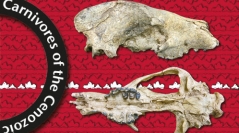

 Geodiversitas
42 (5) - Pages 57-67
Geodiversitas
42 (5) - Pages 57-67The Neogene sediments of the North American midcontinent, undisturbed by tectonism, have long been the source of abundant well-preserved mammalian faunas critical to the definition of the North American Land Mammal ages (NALMA). In western Nebraska the early Miocene interval (c. 23 to 16 Ma) is exceptional for its succession of Arikareean and Hemingfordian mammals that establish a biostratigraphic standard for the region. Fluvial sands, silts, and gravels of the paleovalleys and floodplains of the Runningwater Formation (c. 18 Ma) have yielded a rich carnivore assemblage of more than 24 species, many of these representing Old World lineages that migrated into North America via the Bering corridor. Amphicyonid carnivores, among the largest of the Runningwater predators, often surpass their Old World equivalents in completeness and condition, and include species of the immigrant genus Cynelos Jourdan, 1862. Here is described the only intact skull and jaws of Cynelos known from the New World. It is assigned to a new species, Cynelos stenos n. sp., that in its size, the association of a cranium with articulated mandibles, and in its dentition (occlusal detail of P4-M3, m1-3) differs from all others of this genus previously reported from both North America and Europe.
Nebraska, Miocene, Carnivora, Amphicyonidae, new species